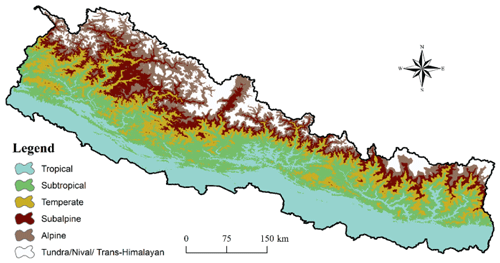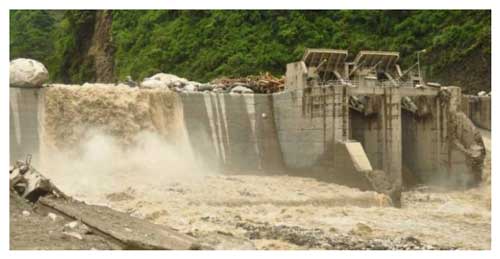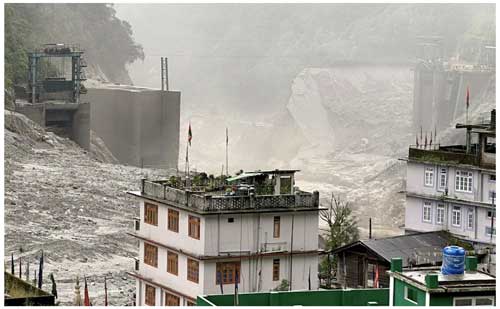the Creative Commons Attribution 4.0 License.
the Creative Commons Attribution 4.0 License.
Review on assessing climate-change-induced risks to run-of-river hydropower infrastructure in Nepal
Shraddha Kadel
Santosh Chaudhary
Shyam Sundar Khadka
Nepal annually invests millions of dollars in hydropower development, with a substantial portion of these funds allocated to civil infrastructure. Climate change, which impacts geological and hydrological conditions, poses a threat to civil components throughout hydropower project construction and operation. This causes budget overruns, project delays, and adverse consequences for society and the environment, ultimately resulting in multimillion-dollar losses. The identification of risk factors and their underlying causes, stemming from the impacts of climate change, constitutes a fundamental aspect of this study. This critical analysis primarily draws upon extensive literature reviews to pinpoint these factors (risk factors arising from climate change), emphasizing their economic and human impacts. This paper highlights the risks to run-of-river hydropower infrastructures in Nepal. The findings of the study can be used to develop and implement adaptation strategies to mitigate the risks posed by climate change to Nepal's vital hydropower sector.
- Article
(5669 KB) - Full-text XML
- BibTeX
- EndNote
Nepal's perennial rivers hold tremendous potential for hydropower development, offering a sustainable and environmentally friendly source of energy. Presently, hydropower plays a pivotal role in meeting approximately 96.2 % of Nepal's electricity needs (Basnet, 2022), and more than 90 % of hydropower is run-of-river type (Bhatt, 2017). Nepal took a significant step in the 1990s when frameworks, guidelines, regulatory bodies and acts were introduced (Nepal and Jamasb, 2012). This sector has attracted private investments exceeding NPR 55 billion (Lamsal, 2012). However, Nepal's geographical location within an earthquake-prone region and its proximity to the industrially advanced nations of India and China pose distinctive challenges. Nepal contributes a mere 0.1 % of global carbon emissions (World Bank, 2022), but it is in the fourth position with respect to vulnerability to the impacts of climate change (Joshi et al., 2019). This means that Nepalese regions covered in glacier and ice, encompassing 113 000 km2 (Bhatt, 2017), are prone to glacial lake outburst floods (GLOFs), landslides and flash floods, especially in areas susceptible to seismic activity. In June of 2023, according to the Independent Power Producers' Association, Nepal (IPPAN), a total of 30 hydropower projects, with a combined capacity of 463 MW, were damaged. To protect the nation's investments in hydropower and ensure the safety of lives and property, it is important to establish a resilient foundation for hydropower development, considering the potential impacts of climate change; to avert future damage; and to effectively manage the associated risks (Wagle, 2022). As per the Nepal Electricity Authority (NEA) fiscal report of 2022/2023, there is a total hydropower project capacity of 2684 MW, with the commissioning of new projects equivalent to the capacity of 491 MW (NEA, 2023).
2.1 Climate scenario, climate change and topography of nepal
Nepal's geography is distinctly partitioned into five major tectonic zones: the Terai, the Siwaliks, the Lesser Himalayas, the Higher Himalayas, and the Tibetan–Tethys zones (Upreti, 2001). This gives rise to five distinct climatic zones throughout the country, as illustrated in Fig. 1.
Based on climate data analysis from 1971 to 2014 (DHM, 2017), Nepal's annual maximum temperature trend is significantly positive (0.056 °C yr−1). The country's annual minimum temperature trend is also positive (0.002 °C yr−1), although insignificant. No significant trend is observed in precipitation in any season. All five physiographic regions show a significant positive trend in all seasons, except for the Terai in winter and in the pre-monsoon season and the Siwaliks in winter. In high-mountain regions and the Higher Himalayas, the highest positive trend is observed in winter season, whereas the highest positive trend is observed in the monsoon season in the Terai, Siwaliks and middle-mountain regions.
Nepal has witnessed alterations in temperature and mean precipitation. Between 1975 and 2005, temperature data indicated an annual increase of 0.06 °C (Upadhayaya and Baral, 2020), while mean rainfall exhibited a significant decrease at an average rate of 3.7 mm (−3.2 %) per month per decade. Mean annual temperatures are anticipated to rise between 1.3 and 3.8 °C by the 2060s and by between 1.8 and 5.8 °C by the 2090s, while annual precipitation is expected to decline by 10 %–20 % nationwide (Bhatt, 2017). Multiple general circulation models converge with respect to projecting ongoing warming trends, with anticipated mean temperature increases of 1.2 and 3 °C by 2050 and 2100, respectively (Agrawala, 2003).
Figures 2 and 3 show two graphs with data about Nepal's climate. Figure 2 depicts the yearly mean temperature from 1981 to 2065, demonstrating a consistent rise in temperature. For the same time period, Fig. 3 indicates an increasing trend in precipitation levels. Both graphs demonstrate how the environment in Nepal is being affected by climate change.
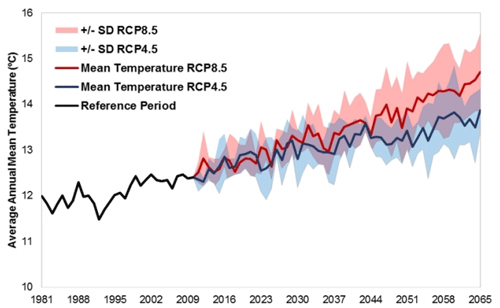
Figure 2Annual mean temperature from 1981 to 2065; the chart estimates temperature changes from 0.9 to 1.1 °C (2016–2045) and from 1.3 to 1.8 °C (2036–2065) (source: Pradhananga and Nepal, 2020).
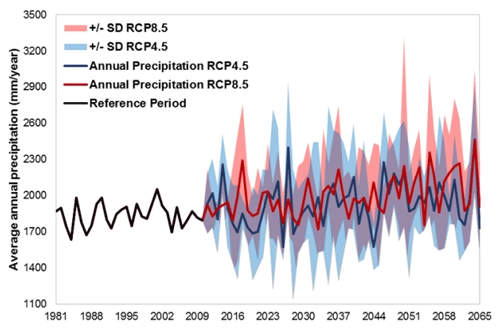
Figure 3Annual precipitation from 1981 to 2065; the chart estimates precipitation changes from 2.1 % to 6.4 % (2016–2045) and from 7.9 % to 12.1 % (2036–2065) (source: Pradhananga and Nepal, 2020).
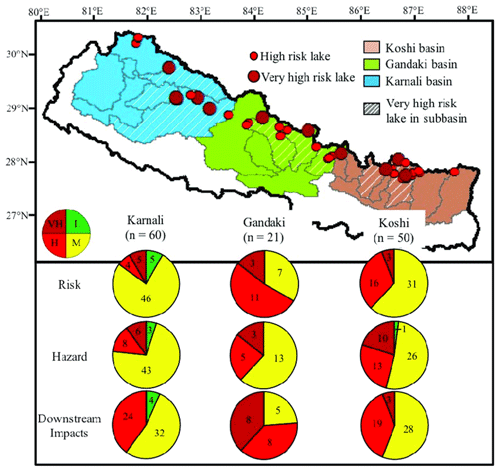
Figure 4The distribution of risk, hazard and downstream impact classifications (pie charts) for each basin. Here, VH denotes very high risk, H denotes high risk, M denotes medium risk and L denotes less risk (source: Rounce et al., 2017).
Around 17 % of the Great Himalayas region is covered by glaciers and ice, spanning an area of nearly 113 000 km2, with 35 000 km2 dedicated to glaciers (Bhatt, 2017). There are 22 districts with a high vulnerability to landslides, 12 districts prone to GLOFs and 9 districts susceptible to flooding. Major threats are seen in Bhotekoshi, Tama Koshi, Marsyangdi, Arun and Dudh Koshi (NAPA, 2010).
A risk assessment map for lakes in the Karnali, Gandaki and Koshi basins is shown in Fig. 4. Lakes in high danger are denoted by red dots in each color-coded basin. The risk, hazard and downstream implications are shown in detail in the pie charts beneath the map. In general, this evaluation is essential for controlling the dangers connected to these lakes.
2.2 Impact of climate change on hydropower infrastructure
A rise in precipitation levels can trigger a cascade of challenges, including flash floods, erosion in catchment areas, landslides and slope failures, which pose a significant risk to critical components of hydropower infrastructure, such as reservoirs, intake structures and transmission lines. Intensifying heat can lead to the accelerated melting of glaciers, potentially culminating in GLOFs (Khanal, 2021).
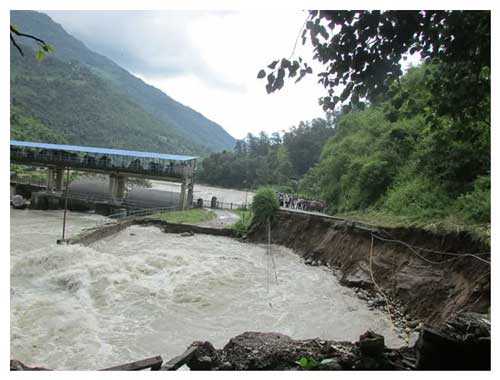
Figure 5The Jure landslide damaged the road and headwork of the Sunkoshi hydropower project (source: Panthi, 2021).
Geological conditions and the risk of flooding were found to be the third and fourth most substantial challenges, respectively (Gurung, 2020). In the case of built–own–operate–transfer (BOOT) hydropower projects, geological risks emerged as the predominant concern in Nepal, often posing considerable disruptions during the construction phase (Tripathi and Shrestha, 2018). Research carried out in the Sapta Koshi River basin indicated that the flow pattern of the river has not varied much over the last 30 years, despite the effect of climate change (Khadka et al., 2018). There is a high sediment content in Nepal's rivers, coupled with topographical factors that increase the likelihood of rockfalls and landslides with localized particle properties potentially featuring fresh, sharp edges (Thapa et al., 2005).
Historically, Nepal has faced a series of devastating natural disasters. On 4 August 1985, there was a GLOF in Dig Tsho Lake, in the Langmoche Valley (Vuichard and Zimmermann, 1986), which led to the catastrophic destruction of the Namche hydroelectric project (HEP), damaging over USD 2–3 million and destroying 30 residential houses. Subsequently, on 27 August 2008, a massive flood swept away the 4 MW Khudi HEP which operated in 2007. This flood caused damage of NPR 8 440 147 (B. P. C., 2008).
On 2 August 2014, a catastrophic landslide in Jure created a dam blockage in a river, posing a significant threat to people living downstream. This disaster resulted in the loss of 10 % of the nation's hydropower capacity, amounting to 67 MW. It submerged a 5 MW power plant and severed connections with the 45 MW Bhotekoshi HEP and 10 MW Sunkoshi HEP. The landslide led to the destruction of over 400 houses, claimed the lives of 156 people and resulted in damage totaling more than USD 25 000 (van der Geest, 2018; Bhatt, 2017). Figure 5 illustrates the damage caused by the Jure landslide in the headworks of the Sunkoshi HEP.
The 7.8 (on the Richter scale) earthquake that struck Nepal on 25 April 2015 resulted in significant repercussions with respect to the country's hydropower infrastructure: more than 14 hydropower dams were damaged (Schneider, 2015). The 24 MW Trishuli 3A plant was hit by a landslide that killed four people and formed cracks in the reservoir crest of the Kulekhani HEP (Schneider, 2015). The 14 MW plant located downstream at Devighat was rendered nonoperational until the Trishuli 3A plant could be restarted (Fairley, 2015). A total of 14 of the 34 hydropower projects were damaged between 2015 and 2020. The 200 kW Malagad hydropower project was damaged in the floods of 2020, impacting 46 powered factories (UNDP, 2023).
On 6 July 2016, a landslide dam in Nyalam, Tibet, burst, leading to the Upper Bhotekoshi HEP, with a capacity of 36 MW, being swept away and resulting in infrastructure damage totaling USD 406.739 million (Khanal et al., 2015; Bhatt, 2017). Figure 6 depicts the damage incurred in the hydropower reservoir of Upper Bhotekoshi HEP.
The frequency of floods and landslides has resulted in significant damage along roads, impeding the flow of construction supplies. As such, there have been notable setbacks in the development of multiple hydroelectric projects. The impact of floods has been severe, according to IPPAN, damaging 16 active projects and causing operational disruptions to 10 electricity-generating projects. It is believed that the damage resulting from landslides and floods brought on by continuous rains has amounted to approximately NPR 3 billion. The Super Madi Hydropower project in Madi, Kaski, is one of these, and it alone has lost more than NPR 1 billion, demonstrating the extent of the difficulty that the construction industry faces.
As reported by IPPAN, the floods that occurred on 16 and 17 June 2023 in the Taplejung, Panchthar, Sankhuwasabha and Bhojpur districts resulted in substantial damage to a total of 30 hydropower projects, with a combined capacity of 463 MW. Figure 7 illustrates some of the major affected hydropower projects.
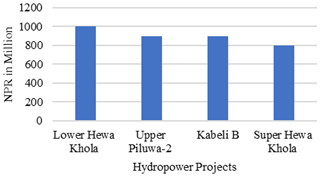
Figure 7Bar graph showing the damage to major hydropower projects due to the flash flood which occurred in June 2023 (source: The Annapurna Express newspaper, 26 June 2023; the República newspaper, 24 June 2023).
From a total of 30, 13 operating projects with a cumulative capacity of 132 MW incurred losses of approximately NPR 6 billion, while 17 hydropower projects under-construction, with a total capacity of 327 MW, suffered losses exceeding NPR 2 billion. A total of 18 workers were swept away by the flood at the Super Hewa Khola project site. The hydropower plants faced a total damage bill of NPR 8 billion. Figure 8 illustrates the damage caused by the floods on 16 and 17 June. Figure 9 depicts the damage to the Hewa HEP due to the flood on 16 June 2023.
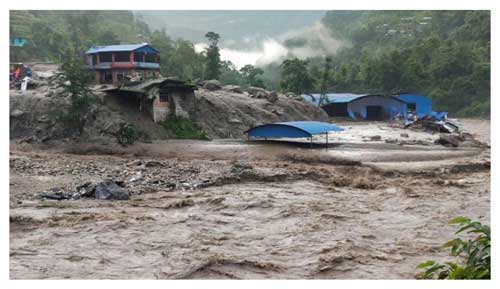
Figure 8Damage due to the flood on 16 and 17 June 2023 (source: the República newspaper, 24 June 2023).
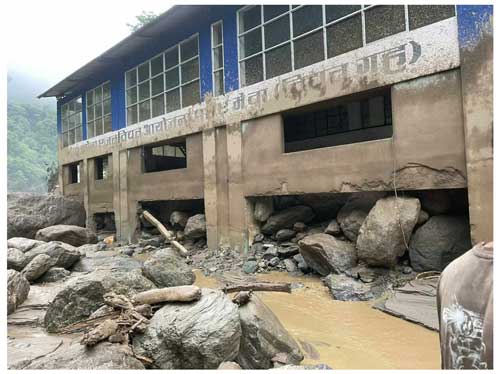
Figure 9Damage to the Hewa HEP due to the flood on 16 June 2018 (source: The Annapurna Express newspaper, 26 June 2023).
In April 2023, a landslide occurred at the construction site of the 900 MW Arun III hydropower project, creating the potential for a flash flood. To mitigate this risk, immediate action was taken to shut down the tunnel. Figure 10 shows the blockage at the Arun III Dam site.
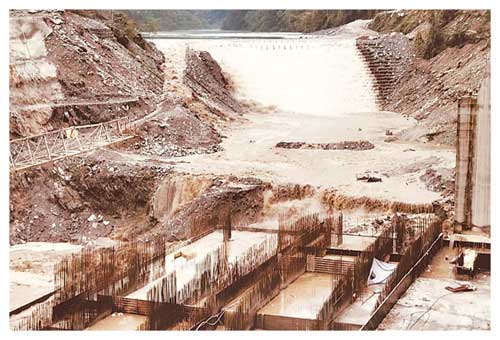
Figure 10A diversion channel blocked at the Arun III Dam site due to a landslide (source: The Kathmandu Post newspaper, 1 May 2023).
The flood on 4 October 2023, resulting from a glacial lake outburst originating from South Lhonak in Sikkim, destroyed the 1200 MW Chungthang Dam. This incident serves as a stark reminder of the growing threat to Nepal's hydropower projects, including Tamor, Arun and Kabeli, currently under construction. The damage done to Chungthang Dam is shown in Fig. 11.
Nepal's mean annual temperature has been rising by 0.06 °C annually, and the country's Himalayan area is experiencing a higher rate of climate change than the rest of the world (Upadhayaya and Baral, 2020). Projections suggest a temperature rise of 1.2–3 °C and a precipitation decrease of 10 %–20 % by 2050 (Bhatt, 2017). The impact of climate change is strikingly evident in Nepal's hydropower sector, which currently boasts an operational capacity of 2684 MW, with the commissioning of new projects equivalent to a capacity of 491 MW that are heavily dependent on run-of-river sources (NEA, 2023). The country has faced increased flooding, landslides and glacial outbursts. As reported by IPPAN, the floods that occurred on 16 and 17 June 2023 alone resulted in damage totaling a capacity of 463 MW to hydropower projects and financial loss of over NPR 8 billion. Escalating climate-induced volatility raises concerns about outbursts of glacial lakes, which cover 35 000 km2 of the nation's land. This underscores the urgent need for an early-warning system, design parameter adaptations and increased investment to mitigate climate change effects on the hydropower sector.
In conclusion, research findings highlight Nepal's urgent climate change challenges, especially with respect to the hydropower sector. The increased temperatures and reduced precipitation, along with the anticipated changes in the country's environment, underscore the vulnerability of the nation's hydropower and reservoir infrastructure. Significant financial losses and human casualties have resulted from the recent catastrophic occurrences, including landslides, floods and glacial outbursts. The increasing effects emphasize how crucial it is to take quick action, such as modifying design specifications, putting an efficient early-warning system in place and increasing funding for climate resilience initiatives. It is critical to address these problems to protect Nepal's hydropower industry, promote sustainable development and lessen the wider socioeconomic effects of climate change.
This study utilized data from journal articles, book sections, annual reports, conference proceedings, and newspapers. Data sources include the Nepal Electricity Authority (NEA, 2023, https://www.nea.org.np/annual_report), Department of Hydrology and Meteorology (DHM, 2017, https://www.climatenepal.org.np/resources/observed-climate-trend-analysis-nepal-1971-2014), National Adaptation Programme of Action (NAPA, 2010, https://adaptation-undp.org/resources/assessments-and-background-documents/nepal-national-adaptation-programme-action-napa) and various newspapers, all of which are cited in the references and figure captions.
The foundational concept was formulated by SSK, under whose guidance SK conducted data collection and review. SC and SK carried out the writing and editing processes.
The contact author has declared that none of the authors has any competing interests.
Publisher’s note: Copernicus Publications remains neutral with regard to jurisdictional claims made in the text, published maps, institutional affiliations, or any other geographical representation in this paper. While Copernicus Publications makes every effort to include appropriate place names, the final responsibility lies with the authors.
This article is part of the special issue “Mountain Hydrology and Cryosphere”. It is a result of the International Conference on Mountain Hydrology and Cryosphere, Kathmandu and Dhulikhel, Nepal, 9–10 November 2023.
We thank the Department of Civil Engineering for this opportunity and for funding for paper publication.
Agrawala, S.: Development and climate change in Nepal: Focus on Water Resources and Hydropower, Organisation for Economic Co-operation and Development, https://inis.iaea.org/search/search.aspx?orig_q=RN:36000404 (last access: 7 June 2024), 2003.
Basnet, S.: The role of and challenges and prospects for hydropower development in Nepal's energy sector, Nepal Econ. Forum, https://nepaleconomicforum.org/the-role-of-and-challenges-and-prospects-for-hydropower-development-in-nepals-energy-sector (last access: 18 July 2024), 2022.
Bhatt, R. P.: Hydropower Development in Nepal-Climate Change, Impacts and Implications, in: Renewable Hydropower Technologies, 3rd edn., edited by: Rajakaruna, M., IntechOpen, https://www.intechopen.com/chapters/53350 (last access: 18 July 2024), 2017.
B. P. C.: Annual Report 2008, Buddha Nagar, Kathmandu: Butwal Power Company Limited, https://www.bpc.com.np/investor-relations/annual-report (last access: 18 July 2024), 2008.
DHM: Observed Climate Trend Analysis in the Districts and Physiographic Regions of Nepal (1971–2014), Department of Hydrology and Meteorology, Kathmandu, https://www.climatenepal.org.np/resources/observed-climate-trend-analysis-nepal-1971-2014 (last access: 18 July 2024), 2017.
Fairley, P.: Nepal Hydropower Battered but not Beaten by the quake, IEEE Spectrum, https://spectrum.ieee.org/nepals-hydropowerbased-power-system-survived-its-m79-quake- (last access: 18 July 2024), 2015.
Gurung, S.: Risk Analysis for the Sustainable Hydropower Development in Nepal, Int. J. Adv. Eng. Sci. Appl., 1, 1–10, https://doi.org/10.47346/ijaesa.v1i2.39, 2020.
Joshi, A., Farquhar, S., Assareh, N., Dahlet, L., and Landahl, E.: Climate change in Lamjung District, Nepal: meteorological evidence, community perceptions, and responses, Environ. Res. Commun., 1, 025005, https://doi.org/10.1088/2515-7620/ab1762, 2019.
Khadka, S. S., Bhattarai, U., and Maskey, R. K.: Standardization of Civil Design Framework for Small Hydropower Projects: Assessing Existing Design Procedures and Considering Impacts of Climate Change, in: Proceedings of the 2018 International Conference on Developments in Renewable Energy Technology (ICDRET'2018), https://www.researchgate.net/publication/344167720_Standardization_of_Civil_Design_Framework_for_Small_Hydropower_Projects_Assessing_Existing_Design_Procedures_and_Considering_Impacts_of_Climate_Change (last access: 18 July 2024), 2018.
Khanal, N., Hu, J.-M. and Mool, P.: Glacial Lake Outburst Flood Risk in the Poiqu/Bhote Koshi/Sun Koshi River Basin in the Central Himalayas, Mt. Res. Dev., 35, 351–364, 2015.
Khanal, S.: Climate Risk and Adaptation Assessment for Hydropower Project in Nepal, Future Water, https://www.futurewater.eu/projects/climate-risk-and-adaptation-assessment-for-hydropower-project-in-nepal (last access: 18 July 2024), 2021.
Lamsal, M.: Private Sector Investment In Hydropower Reaches Rs 55 Billion, Kathmandu, https://www.newbusinessage.com/articles/view/1541 (last access: 18 July 2024), 2012.
NAPA: National Adaptation Programme of Action, Nepal Climate Change and Development Portal, https://adaptation-undp.org/resources/assessments-and-background-documents/nepal-national-adaptation-programme-action-napa (last access: 12 May 2024), 2010.
NEA: Nepal Electricity Authority a year in a review-fiscal year 2022/2023, Durbar Marg, Kathmandu: Nepal Electricity Authority, https://www.nea.org.np/annual_report (last access: 18 July 2024), 2023.
Nepal, R. and Jamasb, T.: Reforming small electricity systems under political instability: The case of Nepal, Energy Policy, 40, 242–251, 2012.
Panthi, K. K.: Assessment on the 2014 Jure Landslide in Nepal – a disaster, Mech. Rock Eng. Theory Pract., 833, 012179, https://doi.org/10.1088/1755-1315/833/1/012179, 2021.
Paudel, B., Pandaya, D., and Dhakal, K.: Climate, The Soils of Nepal, 15–27, https://www.springerprofessional.de/en/climate/19759384 (last access: 18 July 2024), 2021.
Pradhananga, S. and Nepal, S.: Climate change scenarios, ICIMOD, Kathmandu: Regional climate change projections: Climate change, https://www.icimod.org/wp-content/uploads/2020/11/Day2_Climate_Change_NAP_CORDEX_data_analysis.pdf (last access: 18 July 2024), 2020.
Rounce, D. R., McKinney, D. C. and Watson, C. S.: Identification of Hazard and Risk for Glacial Lakes in the Nepal Himalaya Using Satellite Imagery from 2000–2015, Remote Sens., 9, 654, https://doi.org/10.3390/rs9070654, 2017.
Schneider, K.: Nepal Earthquake Damages At Least 14 Hydropower Dams, Circle Blue, WaterNews, https://www.circleofblue.org/2015/world/nepal-earthquake-damages-at-least-14-hydropower-dams/ (last access: 18 July 2024), 2015.
Thapa, B., Shrestha, R., Dhakal, P. and Shrestha, B. S.: Problems of Nepalese hydropower projects due to suspended sediments, Aquat. Ecosyst. Health Manage., 8, 373–379, 2005.
Tripathi, P. and Shrestha, S. K.: Risk Assessment of Boot Hydropower Projects in Nepal Using Fuzzy Logic Approach, J. Adv. Coll. Eng. Manage., 4, 9–16, 2018.
UNDP: How energy is transforming communities in Bajura, UNDP Nepal, https://www.undp.org/nepal/stories/how-energy-transforming-communities-bajura (last access: 18 July 2024), 2023.
Upadhayaya, R. P. and Baral, M. P.: Trends of Climate Change in Some Selected Districts of Western Nepal, Janapriya J. Interdiscip. Stud., 9, 148–158, 2020.
Upreti, B. N.: The physiographic and geology of Nepal and their bearing on the landslide problem, in: Landslide Hazard Mitigation in the Hindu Kush-Himalaya, edited by: Li, T. C., Chalise, S. R., and Upreti, B. N., Kathmandu, International Centre for Integrated Mountain Development, 31–49, 2001.
van der Geest, K.: Landslide Loss and Damage in Sindhupalchok District, Nepal: Comparing Income Groups with Implications for Compensation and Relief, Int. J. Disaster Risk Sci., 9, 157–166, 2018.
Vuichard, D. and Zimmermann, M.: The Langmoche Flash-Flood, Khumbu Himal, Nepal, Mt. Res. Dev., 6, 90–94, 1986.
Wagle, N.: Breaking the bottlenecks: Managing multi-hazard risks in the hydropower sector, Lalitpur: ICIMOD, https://www.icimod.org (last access: 18 July 2024), 2022.
World Bank: Integrating Climate Change into Nepal’s Development Strategy Key to Build Resilience, Says New World Bank Group Report, https://www.worldbank.org/en/news/press-release/2022/09/15/ (last access: 18 July 2024), 2022.






